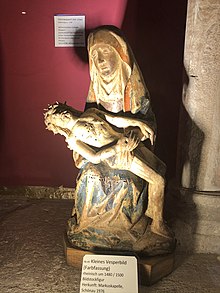Hürten Museum
 The Romanesque house |
|
| Data | |
|---|---|
| place | Bad Münstereifel |
| Art |
city Museum
|
| architect | unknown |
| opening | 1912 |
| Number of visitors (annually) | approx. 1,000 |
| operator |
Friends of the Hürten Museum
|
| management |
Wolfgang Kirsch
|
| Website | |
| ISIL | DE-MUS-008415 |
The Hürten local history museum is located in Bad Münstereifel in the Euskirchen district in North Rhine-Westphalia .
The Münstereifeler Karl Hürten (1856–1925), after whom the museum is named, suggested the creation of a local museum as early as 1900. The museum was finally approved by the city and the rooms in a city gate, the Orchheimer Tor, were made available. The museum was inaugurated in 1912. After a stopover in the town hall, the museum was set up in 1975 in the "Romanesque House", one of the oldest houses in the Rhineland (12th century).
In addition to a dining room from the imperial era around 1900, earlier weapons, works of art from the Middle Ages (including a Pieta from the 15th century), an altar from the 17th century discovered and restored in 2019, 2 large chests, a medieval hearth, the prayer room one The canon with an altarpiece (around 1700) and documents on the city's history from the permanent exhibition. In addition, special exhibitions are organized twice a year in the large Romanesque hall. Reference should be made to the 3 sintered lime columns (material from Roman water pipes) that can be seen inside the Romanesque house.
The permanent archaeological exhibition is open from April to October. Artifacts from the Neolithic, Celtic, Roman and Franconian times to modern times are exhibited.
literature
- W. Kirch and E. Uusitalo: The Romanesque House in Bad Münstereifel, publisher: Friends and sponsors of the Hürten Museum e. V., Druckerei Heinen GmbH, Bad Münstereifel 2017
Web links
- Everything about the museum at www.bad-muenstereifel.de
Coordinates: 50 ° 33 ′ 21.8 " N , 6 ° 45 ′ 47.1" E
